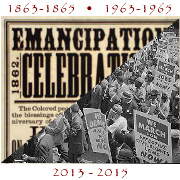The U.S. officially ended slavery with the passage of the Thirteenth Amendment in 1865. There were various proposals to grant freed black slaves compensation, or at least assistance in establishing themselves as free citizens. Most prominent was General William T. Sherman’s field order granting land to black families near the coasts of South Carolina, Georgia, and Florida, which became known as “forty acres and a mule.” Sherman’s order was rescinded, however, after President Lincoln was assassinated, and the Reconstruction Era left formerly enslaved blacks to fend for themselves. In many cases, former slaves simply remained on plantations as sharecroppers in conditions similar to slavery.
In the century following the end of slavery, black Americans faced formidable barriers to political, economic, and social equality. In the South, Jim Crow laws enforced a rigid racial segregation, consigning black citizens to inferior schools and other public services, imposing poll taxes and literacy tests aimed at preventing blacks from voting, and providing official support for a culture of segregation and discrimination. In the North and throughout the rest of the country, there were fewer formal, legal barriers, but rigidly enforced social norms still produced widespread, often blatant segregation and discrimination in employment, housing, schools, churches, and most other aspects of life. Government policies, while not always based formally on race, were frequently designed in ways which benefited whites at the expense of black and other non-white citizens. Race-based violence was also common, and thousands of blacks, and sympathetic whites, were lynched in the South and elsewhere, in waves which occurred periodically from the 1870s until the 1960s.
Meanwhile, this century was one of unparalleled social and economic progress for whites, including many whose families arrived as immigrants after the Civil War. The G.I. Bill, the Federal Housing Authority, and other government programs providing substantial aid to provide citizens with access to education, homeownership, jobs and business loans, raising many whites into the middle class. Meanwhile, these programs were often unavailable to blacks, and unofficial policies such as redlining further restricted access to banking, insurance, health care, jobs, and homeownership for black citizens. The net effect of these policies and practices was to widen the racial equality gap in the century leading up to the civil rights movement.
In the 1950s and 1960s, there was dramatic progress towards official acceptance of equality for those of all races. The Supreme Court struck down laws segregating schools (Brown v. Board of Education), marriages (Loving v. Virginia) and other public accommodations and institutions Following a series of popular protests lead by Dr. Martin Luther King, Jr. and others, the federal government enacted civil rights legislation designed to end legalized discrimination and to ensure equal access, in practice, to schools, voting booths, housing and jobs. The Civil Rights Era, in changing laws and reshaping public attitudes, and new policies such as affirmative action, began to significantly change circumstances for black Americans.
The advances of the 1950s and 1960s, however, were not enough to reverse the failures of Reconstruction or the discrimination of the Jim Crow era. Black Americans made little progress during the century following slavery, while falling further behind white Americans, and progress since that time has been glacially slow by most social and economic indicators. The median net worth of white families has risen to about $121,000, while for black families, the figure is only $19,000. Following the dramatic, government-supported rise in homeownership for whites during the 20th century, it would now take black families, at current rates, about 5,423 years to close the gap in homeownership.
Sources: Jonathan Kaplan and Andrew Valls, “Housing Discrimination as a Basis for Black Reparations,” Public Affairs Quarterly (July 2007); Ira Katznelson, When Affirmative Action Was White: An Untold History of Racial Inequality in Twentieth-Century America (New York: W. W. Norton & Co., 2005); Amaad Rivera, Brenda Cotto-Escalera, Anisha Desai, Jeannette Huezo, and Dedrick Muhammad, Foreclosed: State of the Dream 2008 (United for a Fair Economy, 2008).


